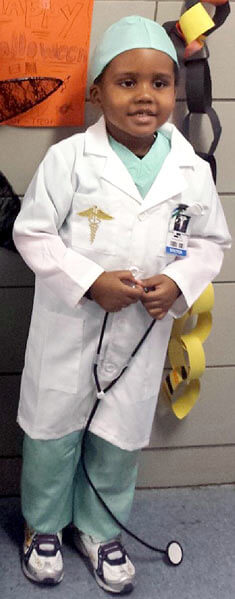By Sarina Trangle
The Mitchell family was poised to move into their Far Rockaway house two weeks before Superstorm Sandy hit.
After weathering the tempest, a series of contractor snafus and their 5-year-old son Nile battling a benign brain tumor, the family finally began settling into their home last month just days before Christmas.
Darrell Mitchell, his wife Isabel Mitchell and their four children relished their first holiday in the house, at 704 Beach 67th St.
“Bam — the flood hit. Then Nile was diagnosed,” Darrell Mitchell, 48, a Metropolitan Transportation Authority bus driver, said Monday. “If I was just by myself, I would’ve given up a long time ago, but having him fighting what he’s fighting, I couldn’t do that. I had to do it for him.”
The Federal Emergency Management Agency provided some assistance to the Mitchells, dispatching skilled workers to help with their ducts and vents.
But shortly after the flood waters receded from their home, the family became ensnared in disputes with contractors. First their walls were installed without city Department of Buildings workers inspecting the interiors, leaving the Mitchells vulnerable to costly fines. Then workers used materials not included in the contract and built structures without consent.
Darrell Mitchell asked the city Department of Consumer Affairs to get involved when the third contractor put up a deck while he was away, despite being advised not to do so. Later, the family learned the contract they had signed violated DCA requirements. The department eventually negotiated a settlement that freed the Mitchells from paying the contractor, but did nothing to compensate them for the money they had already sunk into the house or the rent they had to pay while staying in Brooklyn.
Meanwhile, Nile’s parents began to notice that he was struggling to remember the alphabet and maintain his balance. Thinking he was suffering from the flu like his mother was, they took him to the pediatrician three times in February 2013. Nile’s doctor chalked it up to typical childhood development concerns.
Unconvinced, the Mitchells took Nile to New York Methodist Hospital Feb. 10. There, they said a MRI showed Nile had a tumor with two golf ball-sized cysts pressing up against his pituitary gland and threatening his vision. An ambulance rushed the family to New York Presbyterian Hospital, where a small hole was cut in the top of Nile’s skull to drain out the liquid from the cysts. Still, the tumor remained.
Dr. Jeffrey Greenfield, a pediatric neurosurgeon at New York-Presbyterian’s Komansky Center for Children’s Health, informed Nile’s parents he had craniopharyngioma, a benign tumor that occurs at the base of the brain near the pituitary gland. Greenfield said the condition was not rare in children and doctors had grown adept at removing tumors from them via their nose.
“I’m listening to them and I’m thinking, is it going to be a hairline scar? Is it going to be a big scar in the back?” Darrell Mitchell said while describing how difficult it was to believe such surgery was possible. “But they’re top surgeons, so I know they know what they’re doing.”
The doctors sought to delay removing the tumor for as long as possible, hoping Nile’s nasal passages would open up and his age would give him the strength.
Routine MRIs showed a cyst had ballooned to dangerous levels again this fall. On Nov. 20, he underwent surgery.
Greenfield said medical staff threaded very thin rod-like cameras up his nose, which transmitted images of his brain. This helped them cut through the small bone separating the sinuses from the brain and pull the tumor out from the base.
“We just want to create some awareness that there are other ways to approach some of these tumors,” Greenfield said. “Minimally invasive surgery can be misconstrued as a gimmick or an advertising technique for doctors to try and basically tout their latest and greatest.”
Isabel Mitchell, 50, said doctors were able to remove 98 percent of the tumor during a procedure that lasted close to seven hours The residual 2 percent was stuck to the brain, where doctors will monitor it and, if necessary, prescribe radiation doses to kill it.
Immediately following the surgery, Nile addressed Greenfield by his name, surprising everyone with his alertness.
“At most I was hoping he would remember me,” said Darrell Mitchell. “He’s a strong kid. He smiles through it.”
He was home within two week and back at school after another.
The Mitchells’ first few nights in Far Rockaway were not easy for Nile. His father said the kindergartner was unsure if he liked his new home. After a few days of watching his brother Psalm, 7, run around, Nile began to get accustomed to playing in the yard and admiring the bay. Soon, he was saying he never wanted to return to Brooklyn.
Nile continued donning a surgeon’s cap and smock and scheduling mock appointments with his father at the new house.
He used to prefer car-related costumes, but since his surgery his parents said he has dressed up as Dr. Greenfield and monitored their own symptoms.
“That kind of helped,” Isabel Mitchell said. “He was processing it all while playing.”
The Mitchells say they have grown from the experience, too, particularly after seeing how hospital wings are filled with children with tumors.
“Unless things knock on your door, you really don’t have a clue,” said Mitchell Darrell, who recently learned one of his colleagues had a child with such a tumor. “I’m just so grateful …. And I’m giving a lot more now.”
Reach reporter Sarina Trangle at 718-260-4546 or by e-mail at strangle@cnglocal.com.



































